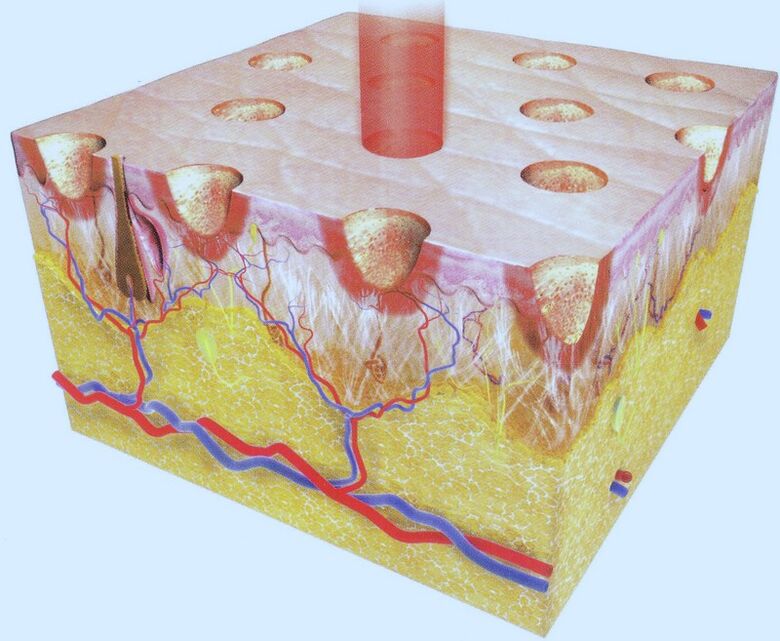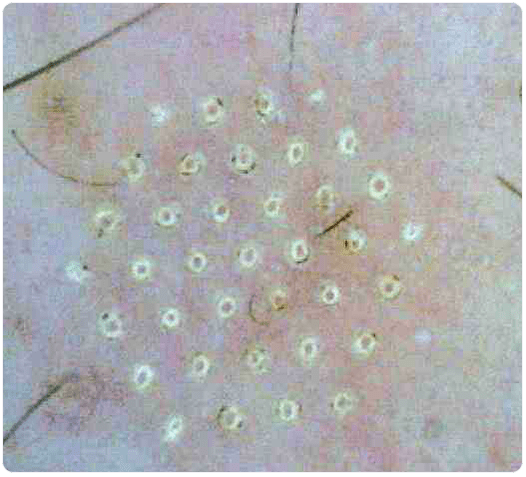
Modern medicine today uses a wealth of hardware techniques and non-hardware procedures to solve the problems of young and aging skin, but photographic and pre-rejuvenation procedures should not be confused with fractional rejuvenation - fractional thermolysis.
Fractional thermolysis is a controlled, effective and safe way to rejuvenate, laser to eliminate various cosmetic defects that is suitable for both aging and young skin. During operation, a laser beam of human hair thickness is formed. In a flash of 1-1, 5 square inches, the laser "drills" a lot of microspheres (laser microcuts) on the skin. Untouched areas remain around each, and damage caused by laser pulses provides a boost to restore the structure of the skin over the entire treated surface.
Consider the technology itself. "Fractional" ablative (ablative) rejuvenation interacts closely with "traditional", where fractional ablative (ablative) rejuvenation creates microthermal damage zones (MTZs) due to "accurate" radiation, alternating with untreated tissues. Consequently, healing is muchfaster (only 1-2 days), allowing you to return to your normal lifestyle immediately.
The laser’s job is to destroy the extremely small portions of old collagen and elastin, and the cells preserved around the affected areas "wake up" and begin to intensively reconstruct the damaged area. Recycled collagen and elastin, as well as other proteins coagulated by the laser in the affected area, are involved in tissue regeneration. New, functionally active skin is formed with all the properties of youthful skin.
The therapeutic effect is determined by the location of the microscopic areas of the skin.
Areas of exposure: face (including upper and lower eyelids, crow's feet), forehead, eyebrow region, temple region, cheeks, nose, nasolabial triangle, chin, neck, décolleté, hands, forearms, mammary glands, abdomen, back, thighs, gluteal regionand other areas.
Fractional thermolysis allows:
- achieve a rejuvenating effect on the skin of the face, neck, décolleté, hands;
- remove wrinkles in the sensitive and delicate area of the eye ("crow's feet");
- eliminates age spots (increased pigmentation, melasma);
- significantly smooth, until complete disappearance, postoperative and traumatic (after cuts and burns) scars;
- fight skin stretch marks;
- corrects the effects of acne (after acne);
- decreased skin tone;
- an alternative to deep chemical peeling.

How the procedure works. Before starting treatment, the skin is cleansed with a disinfectant. The doctor adjusts the parameters required for the operation of the laser in each specific case.
Fractional thermolysis is performed directly by means of a special fixation that allows the same distance between the "front" of the light beam and the skin to be maintained.
During the session, the "flash" of the laser creates a sensation similar to the tingling sensation. The process ends with the application of a nourishing, soothing cream.
The duration of the session and the number of procedures depend on the area being treated and the problem to be resolved.
After the procedure, the rehabilitation period is minimal. The rapid re-epithelialization process ensures the restoration of the epidermal barrier, the reduction of erythema and immediate clinical results (tissue "tension" due to the selective parameters of heat radiation). exfoliation is removed with a mild exfoliator and moisturizer.
In order for the rehabilitation period to run smoothly and for a long time to be achieved, all medical instructions regarding the care of sensitive skin at home must be followed!
Contraindications to fractional thermolysis
- Pregnancy.
- Epilepsy.
- Oncological diseases.
- Acute inflammatory skin diseases.
- Herpes in the active phase;
- Psoriasis.
- Atopic dermatitis in the acute stage.
- Inflammatory processes in the proposed treatment area.
- If less than 2 weeks have passed after chemical peels and similar procedures.
- If less than 2 weeks have passed since the last tanning session.
























